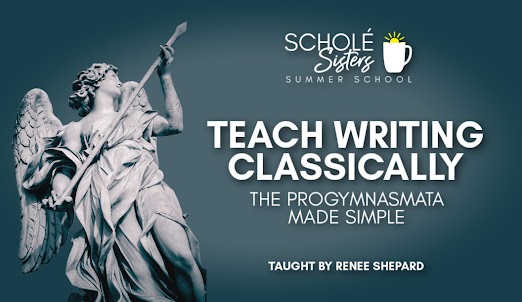
Writing, I believe, is one of the most vital skills we can teach our kids, whether we homeschool or not.
It is so poorly taught in modern education, yet in modern society written communication is necessary & unavoidable. Teaching our kids to write well is one of the best ways to set them apart from the crowd and help them stand out both in college & life.
After all, our children will be writing cover letters, business proposals, sales pitches, emails, church announcements, thank you cards, social media posts, and all manner of written work their entire lives. It behooves us to make sure they know how to do so well.
Yet, how do we teach writing in our homeschools? It seems so subjective, so technical and yet so vague.
There are so many writing programs on the market for homeschoolers right now. Some of them even appear so similar that it can be extremely difficult to know which to choose.
Recently someone – and she was not the first – emailed me to ask,
I was wondering if you might be able to do a blog post about how you teach writing in the younger grades in your homeschool?
And I knew it was time to stop procrastinating on this post.

How I was taught writing when homeschooled
I was homeschooled myself. My parents did not use any particular writing program, but simply assigned a few papers over the course of my teen years. I remember writing 5 pages about the causes of the Civil War and a report about the state of Georgia.
After I wrote something, my mom went through it with a red pen and I cried. Then I made the revisions and then my dad went through it with a red pen and I cried.
Once I tried writing an essay for a writing contest and my friend’s dad edited it. I thought my dad’s technical editing had been brutal. My friend’s dad said half my sentences didn’t connect to the topic or make sense. But when it’s not your parents, you don’t cry.
I entered the local community college at 16 and had an old-school English 101 prof who made us memorize comma rules and would fail the paper if it wasn’t on topic. I also had an English lit instructor who taught us how to write literary analysis, even though that wasn’t technically part of the course.
From there I went on to become an English major at UI, where I took an entire class on sentence diagramming as well as several more writing classes and lit classes that required strong writing. I knew I would likely homeschool. Though I might not be able to teach math well, I would be able to teach writing well.
How I started teaching writing to homeschool kids
So I graduated and my husband and I moved back to our home town. I wasn’t sure what I was going to do with myself exactly. Then a homeschool mom called me and asked if I was interested in teaching writing and literature to a group of kids.
Since I had nothing else to do, I said “sure,” not exactly knowing what I was getting into. She gave me her 1st-generation IEW VHS tapes and my mother-in-law gave me her 1st-generation IEW 3-ring binder. This was before Writing with Ease, before Classical Writing, when IEW was simply teacher/parent training materials rather than a curriculum.
Either curriculum or teacher-training
I taught writing and literature to classes of homeschool kids for about 7 or 8 years, with a few years off here and there depending on when my babies were due. I estimate that I have taught around 50 kids how to write.
Many of my students, who were generally 10-11 years old, had not done any writing at all before taking my classes.In 1-2 years their composition skills rivaled those of the English 101 students I tutored at the University (that says more about English 101 than my teaching).
I have now also taught my two oldest sons to write, and I am positive my oldest – at age 12 – would test out of English 101 and my 10-year-old son would be able to pass it.
They still have a long way to go in becoming good writers. However, the writing requirements of the public school system have sunk so low that what is now college-level English 101 really should be a 7th or 8th grade writing class. My professor in charge of the writing center at UI said as much 14 years ago – I can only imagine it’s worse now.
How to help kids write better at home
I have had multiple students of mine over the years report back that high school and lower-level college English classes covered what I had already taught them in middle school.
However, I don’t think that’s because I am such an awesome teacher. I think it’s because our society’s English standards are so low.
Also, I believe effective writing instruction lies in receiving meaningful feedback and being made to revise papers multiple times. Most classroom teachers simply don’t have the time or resources for that.
My parents might have made me cry with their red pen markings, and I might have made kids cry with my purple pen markings (especially my own), but personal feedback that must be put into practice is the key to improving writing skill.
A teacher with a class of 30 or more cannot read and personally help each student improve their weak spots. But as homeschooling moms, we have the privilege of being able to give our kids individual guidance and attention.
Writing is best taught with the tutoring model, where someone who cares will help each student take the next step to improve his writing ability.
Why I don’t teach writing until 4th or 5th grade
Over and over when I taught writing classes (I mostly taught middle school and higher), I saw that after a year of specific and individualized instruction, I could not tell the difference in ability between the students who had done writing of some sort in their elementary years and those who had not.
The difference in writing skill fell less along the lines of those who had practiced more and instead along the lines of those who had read more and thought more. The truth is, you can’t be a good writer if you don’t have words to use and ideas to communicate.
I taught two 3 & 4th grade level writing classes and resolved after the second to not bother with that level again. It is so difficult and painful to draw the writing out of any but the linguistically gifted 7-9 year old. Why spend 2-3 years going over what could be taught to them in 3-4 months when they are 11 or 12?
Exceptions, sometimes
Now, I broke this rule a smidgen with my own because when it was time to teach my oldest to write, I lumped my second-born into the class as well, even though he was 8 & 9 at the time.
He was linguistically gifted, an early reader, so I thought it’d be ok. It was ok, but it was a struggle for him. Combining ages was the best use of my time, but I could have postponed it another year and it would have been better for my second-born and still not a problem for my oldest.

(This was a first draft written by my just-turned-12-year-old. After snapping the picture, I spotted two more errors: the first sentence has a singular/plural disagreement – it should read “lives” not “life” and if he changes “and then” to “but when” as I suggest, he also needs to remove the but that follows.)
Why make our kids struggle for multiple years learning skills that they can learn with ease and alacrity when they’re just a few years older? It leads to needless tears and headaches. It’s not the best use of our time.
What to do before teaching writing
So if we aren’t teaching 7-9 year-olds composition, what are we doing with them to grow their aptitude?
We do a variety of things that don’t look like writing instruction, but will most definitely improve their communication – including writing – skills when they are ready.
Before they can write well, they have to know how to say things and have things to say.
My biggest frustration in teaching younger elementary kids composition was how often they would phrase things awkwardly and the only thing I could tell them was, “We don’t say it like that, we would say it like this.” They don’t get it. They just made the change, and they begin thinking that writing is a mysterious, confusing, illogical requirement.
Better to surround them and fill them with lots and lots of spoken and written words so they have many language patterns fully internalized. Before they are required to put words on paper, they should be filled up and overflowing with words.
How to foster language skills
These words can be built up in them through
- read alouds
- free reading
- audio books
- memory work
- reading poetry
- memorizing poetry
- watching old movies
- copywork
- copying Psalms, poetry, and quotes
In addition to filling them up with good language, we must also guard against their exposure to poor language. The more they are exposed to texting-speak, dumbed-down cartoons, and twaddle, the less readily they will receive quality language.
We all gravitate toward what is easiest, and so we have to guard their taste and comfort in language during their early school years. If they are kept from twaddle-language, Shakespeare is less of a jump. If we speak to them in complete sentences and require them to speak in complete sentences, then writing complete sentences will come more naturally.
The language they are exposed to will be the language that comes out of them when it’s time to write.
They also have to have things to say.
The most challenging writing students I have had have been the ones who had a few hobbies or interests and did not read or learn outside of their narrow interests.
If their free time was spent in easy television, easy books, easy games, their writing was never going to be high caliber. If a child has not thought about the world, he will not be able to write about it, either. If a child is not interested, he will not be able to write interestingly.
The best foundation for writing, apart from language exposure generally, comes as a side effect of that language exposure: exposure to a wide range of knowledge & ideas.
An interesting and interested child will have the chops to become an interesting and adept writer.
How I teach writing in my homeschool
So, when it does come time to teach a student how to write, what do I do?
My process is based upon the principles of IEW, but adapted to a tutoring style that is more focused on producing a strongly written piece than on checking all the boxes.
Although a formula makes useful training wheels, those training wheels have to come off before we can call the student a writer. The formula must transform into tools to be drawn when required rather than remain boxes to be checked for every paragraph.
4 types of composition
There are several types of writing, and each better fits a different developmental period. We begin with narratives, because it’s the style a child is most familiar with and the simplest to teach through imitation.
The next step is to teach informational writing, where the young writer simply informs without making a proposition, stating an opinion, or having a particular point. Written narrations are generally informational writing.
When the student is in middle school or early high school, he has his own ideas and a general concept of logic and reasoning; then, and only then, should he start using writing to make a point or state an opinion.
The final level of writing is the persuasive essay. This requires not only having and proving an opinion, but understanding an audience and rhetoric well enough to express that opinion convincingly.
My 3-step homeschool writing process
I have three principles for how to help a student improve his writing:
- He requires lots of individual, specific feedback
- He must always revise – a first draft is never a final draft
- He should practice with training wheels, then they should be removed
Any kind of formula for writing, whether it’s using a certain number of openers and styles or following sentence patterns or even paragraph patterns should be treated as training wheels rather than held up as the gold standard.
Such formulas help us practice various skills and teach us that our writing must be cohesive, but good writers do not write by formula. They write with skill, knowing what will best fit their point and their audience. That is the final goal, so do not teach formulas as laws but as helpful guides.
You have to learn how to use tools before you’re set free to do with them whatever you want.
How to give feedback on written work
One of the hardest things about teaching writing is providing each student with useful, helpful feedback.
Here are the things I look for when I’m giving feedback:
- Every sentence is on topic – no rabbit trails or irrelevant details.
- A topic sentence introduces the topic with a statement, a conclusion sentence draws a conclusion about the topic.
- The sentences begin in a variety of ways.
- The sentences are of various lengths and various rhythms.
- The verbs are strong, the nouns specific, and adjectives sparse.
To teach 5-paragraph or not to teach 5-paragraph
I am a believer in the benefits of teaching kids – middle school kids – to write a 5-paragraph paper. Just because the format and formula is often abused, often dull, and often wooden doesn’t mean it has to be, doesn’t mean there’s no value in it.
I love thesis-driven writing. One of the reasons I started my personal blog all over from scratch here at Simply Convivial was that I wanted my writing to have a thesis, a point. I wanted the internet to forget my pointless personal rambles. I wanted to communicate clearly, and the best way to do that is to have a single objective for each piece of writing.
A 5-paragraph paper with a single thesis is the training-wheel format for thesis-driven writing. It is hard work to compose a thesis that encompasses three points, that is not broader than your three paragraph topics, and then that every sentence in every paragraph relates to.
Just because you like a particular detail doesn’t mean it can be in your paper, if it’s not related to the thesis.
Just because you find information interesting doesn’t mean it relates.
It’s not about how you feel about your writing or your research and what you want to say so much as it is about staying on target with a single focus.
A 5-paragraph essay with a thesis teaches students that their writing is not personal expression, but an exercise in clear communication.
Yes, early 5-paragraphs will be rough. Yes, they will graduate past them – they are not the highest form of writing. But they are a helpful stepping stone into writing that is useful, clear, and concise – as long as staying on topic is emphasized.
When a homeschool writing curriculum is necessary
Teaching writing without a curriculum is not for everyone. If you are not comfortable reading closely or not sure about grammar and punctuation, then it’s best to start with a curriculum.
It was only after I had practiced with that method that I learned how to teach it on my own.
As homeschooling mothers, we often aren’t able to get to that place of experience in teaching. Experience allows us to comfortably teach without a curriculum guide. That’s ok. Just remember that even when you use a curriculum, it is only training wheels for you, not law.
Know what’s important to you. Writing does always require personal feedback and interaction. Of course there’s no shame in choosing a curriculum. Simply realize that even with a writing curriculum – you are in charge.
So, which one should you choose?
The best curriculum is one you’ll use.
NEW – I now teach how to give feedback and tutor the writing process in the Teach Writing Classically teacher-training from Scholé Sisters! Click here to learn more.

Get 5 of my favorite homeschool checklist templates!
Jumpstart your homeschool checklist practice by starting with one of my proven formats. Open, edit, and make them your own! Plus, get tips and followup, too –


